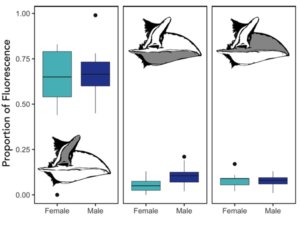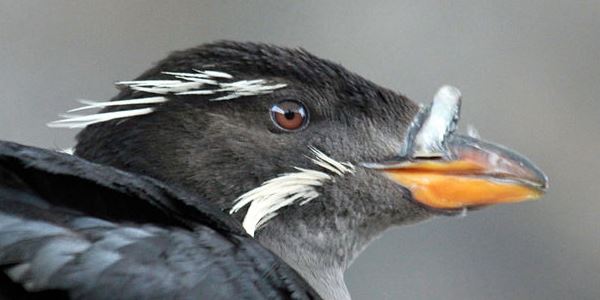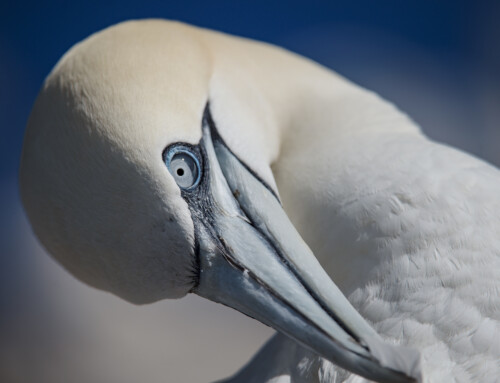
Fluorescent ornamentation in the Rhinoceros Auklet Cerorhinca monocerata. 2019. Bradley P. Wilkinson, Michael E. Johns & Pete Warzybok. IBIS. doi.org/10.1111/ibi.12715 VIEW
The recent discovery of fluorescence in the bills of Atlantic Puffins, Fratercula arctica, has garnered much attention since it first made headlines last spring (Dunning et al. 2018). This charismatic species, sporting garish bills and a comical presence, belongs to an assemblage of birds called auks that inhabit the marine ecosystems of the northern latitudes. This group of seabirds includes many species that, like puffins, have developed extensive ornamentation for the likely purpose of attracting a mate (Jones & Hunter 1999). These markers can include outlandish feathers, bill plates, and even behaviors that are all involved in reproduction. And in fact, puffins are not even the only auk to have fluorescent bills! Another species, the Crested Auklet, Aethia cristatella, has also been shown to have fluorescent properties in their seasonally-acquired bill plates (Wails et al. 2017).
Given this information, we wanted to see whether another auk, the Rhinoceros Auklet, Cerorhinca monocerata, would show fluorescence in their ornamental structures as well. Rhinoceros Auklets are very closely related to puffins, and in fact some scientists even consider them the ‘fourth’ puffin species. Regardless, they derive the first part of their name from a keratin-based ‘horn’ that is grown at the base of the upper mandible during the breeding season (Sorensen et al. 2010). We hypothesized that this horn may be a likely source of fluorescence, given its probable role as an ornamental structure and how similar auklets are to puffins.
With a field station on the Farallon Islands off the coast of central California, Point Blue Conservation Science has access to hundreds of breeding auklets every summer. With no luck from recent Peregrine Falcon, Falco peregrinus, kills, which occasionally predate adult auklets on the island, we looked to living subjects already being handled for an ongoing diet study. Setting up mist nets around breeding burrows, we eagerly awaited adult auklets to return to their nests at dusk with bills full of fish for their waiting chicks. Carefully extracting them from the net, we went to process each individual. Excitingly, it turns out our suspicions about fluorescence were correct!

Figure 1 Photographs of three rhinoceros auklet bills under UV light, illustrating the amount of variation in the pattern of fluorescence in the upper and lower mandibles, and horn between individuals. Fluorescence is observed as a relatively narrow band in the horn only (a; female), in all three bill segments (b; male), and as a near fully fluorescent horn (c; female)
After safely exposing their bills to a UV light source, hiding beyond our detection after all these years was a novel discovery; a unique turquoise glow. Concentrated mainly on the horn, every subject that we examined displayed at least some amount of fluorescence. Some individuals showed more than others, especially on the mandibles, but this variation was not because of sex.

Figure 2 Boxplot showing the difference in the proportion of fluorescence across bill segments (horn, lower mandible, and upper mandible; shaded in grey) and by sex. Shaded box indicates the interquartile range bounded by the 25th and 75th percentile, bold horizontal line the median, whiskers the maximum and minimum values, and dots the extreme outliers
While the mechanisms and biological significance of this trait is less understood, we suggest that it likely aids in reproductive signaling. This may be especially true given this species’ crepuscular habits, when many interactions take place just after dusk or right before sunrise. During these times, ambient light is low and ultraviolet spectrums may be enhanced, serving to highlight the horn to conspecifics (Kohler et al. 2019). More research into auklet fluorescence is clearly needed, but we are excited to report this unusual phenomenon in another member of this already unique group of seabirds. Releasing our birds back into the darkness of the sea from whence they came, we were once again reminded how many things lay yet undiscovered about even the relatively common species around us.
Read the paper:
Fluorescent ornamentation in the Rhinoceros Auklet Cerorhinca monocerata. Wilkinson, B.. 2019. IBIS. VIEW
Nominate this article for a BOU Science Communication Award.
References
Dunning, J., Diamond, A.W., Christmas, S.E., Cole, E., Holberton, R.L., Jackson, H.J., Kelly, K.G., Brown, D., Rojas Riveras, I. & Hanley, D. 2018. Photoluminescence in the bill of the Atlantic Puffin Fratercula arctica. Bird Study 65: 570–573. VIEW
Jones, I.L. & Hunter, F.M. 1999. Experimental evidence for mutual inter-and intrasexual selection favouring a Crested Auklet ornament. Animal Behaviour 57: 521–528. VIEW
Kohler, A.M., Olson, E.R., Martin, J.G. & Anich, P.S. 2019. Ultraviolet fluorescence discovered in New World flying squirrels (Glaucomys). Journal of Mammology DOI: 10.1093/jmammal/gyy177. VIEW
Sorensen, M.C., Hipfner, J.M., Kyser, T.K. & Norris, D.R. 2010. Pre‐breeding diet influences ornament size in the Rhinoceros Auklet Cerorhinca monocerata. IBIS 152: 29–37. VIEW
Wails, C.N., Gruber, E.D., Slattery, E., Smith, L. & Major, H.L. 2017. Glowing in the light: fluorescence of bill plates in the Crested Auklet (Aethia cristatella). Wilson Journal of Ornithology 129: 155–158. VIEW
Image credits
Featured image: Rhinoceros Auklet (Cerorhinca monocerata) | Dick Daniels | CC BY-SA 3.0
If you want to write about your research in #theBOUblog, then please see here.






